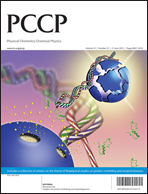The induced ability of bisulfite to facilitate the hydrolytic deamination of the protonated cytosine-SO3− has been studied at the MP2/6-311++G(3df,3pd)//B3LYP/6-311++G(d,p) level and CBS-QB3 approach, respectively. In the gas phase, two distinct groups of mechanisms were explored, the direct hydrolytic deamination (path A) and HSO3−-induced hydrolytic deamination (paths B–D), and it indicates that the direct hydrolytic deamination of protonated cytosine-SO3− (path A) is unlikely because of the high activation free energy involved in the rate-limiting step, whereas the presence of bisulfite (paths B–D) significantly contributes to decreasing the activation free energy. In the aqueous phase, although the solvent effects of water significantly decrease the activation free energy of path A, the direct hydrolysis reaction remains unfavorable and the HSO3−-induced mechanism is still more favorable, which is in agreement with previous experimental data. The pseudo-first-order rate constant (k′) for direct hydrolysis is obviously smaller than that of HSO3−-induced hydrolytic deamination, which is the most plausible mechanism, where the calculated the k′ (1.99–3.81 × 10−5 s−1) is in close proximity to the experimentally determined the pseudo-first-order rate constant (26.2 × 10−5 s−1). Furthermore, the results also manifest that there is a positive correlation between the k′ and temperature, and the ratio of reaction rates between direct hydrolysis reaction and HSO3−-induced hydrolytic deamination increases with the increase of the bisulfite concentration at a given temperature.

You have access to this article
 Please wait while we load your content...
Something went wrong. Try again?
Please wait while we load your content...
Something went wrong. Try again?


 Please wait while we load your content...
Please wait while we load your content...